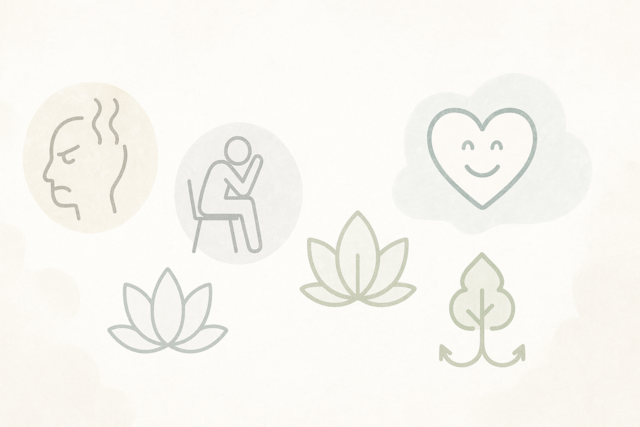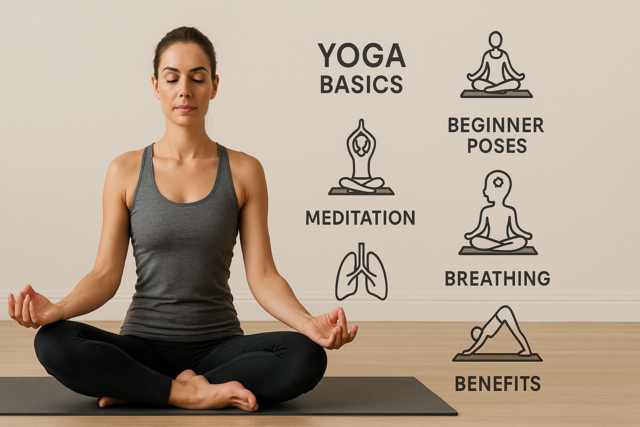Breathing and Meditation have a reciprocal relationship: Controlled breathing will help you meditate, and meditating will help you with controlled breathing.
Whether you already meditate, or have an interest in starting, controlled breathing is a big part of it.
| The Breathing Paradox: Conscious breathing can make breathing almost imperceptible! |
What does it mean to meditate?
In its most simple terms, meditation means to contemplate. The word finds its origins in Latin, from the verb meditari. There isn't one "official" type of meditation. Basically, any practice that aims to focus the mind and induce the concentration and pondering of a single point, in order to bring you some type of benefit, can be called meditation.
There is a wide variety of ways, methods, and styles of meditation, and breathing plays an important part in all of them. There are several different approaches: You should choose one that fits you best, and that you are most comfortable with.
| A couple of things you should know: Anyone can meditate. Just like controlled breathing, the action of meditation is a highly individual and personal task, though it can be performed in groups, as well. Modern meditation usually involves the focusing on a singular trait; that can be whatever you choose: serenity, loyalty, compassion, self-control, you name it. Your breathing is essential in achieving this focus on a particular trait.
Although there are dozens of meditation techniques out there, all of them have one thing in common: one-pointedness, the ability to focus on one thing at a give moment, for a certain period of time. |
Here is a simple exercise on focus and breathing:
| - Take three pieces of paper. Draw a black circle on each one, about the size of a dime or smaller. - Hang them on the wall, sit away from them, and breathe slowly -- as if in a circular, continuous pattern. Spend 20 minutes at a time looking at one of the circles � just one � without allowing kinetic motion, and simply holding your focus exactly on that one point, and nothing else. Just aim. - You won't think of anything else, and may even forget about your breathing. Though you want your focus to be on the black circle, you will start developing, not only an accurate sense of focus, but also a sharp sense of a passive consciousness of your breathing patterns. That means you are aware and in control of your breathing in an effortless manner, which enhances your capacity to focus on a single point. |
Remember, focus and tension are two very different things.
On to Meditation
Find a comfortable position.
Most people find that a sitting position is the best for meditation. For some techniques, some prefer lying down.
If you choose to sit, you can either find a comfortable position sitting on a chair or on the floor, with or without a pillow.
Either way, make sure you are connecting to the floor, preferably with your feet.
Tip: The "lotus position" is recommended if you are comfortable with it. Though it is a "stereotypical" meditation position, it is so for a reason: It allows your back to be straight, your hands to be relaxed, and your breathing to flow freely!
Before we get started, here are some things that will make meditating a much easier and more pleasant experience. Meditation doesn't require any equipment, but these unofficial rules will come in handy:
| - Find a quiet, serene space. - Wear comfortable clothes. - Prevent disturbances by silencing your phone, or shutting it off. - Do a small stretching routine before and after meditating. - Establish a time of the day you want to meditate and make it become a routine. |
Starting
- Once you have found a comfortable position, straighten your back and see yourself grounded to the earth, connected to floor. Imagine a line -- going from your tail bone up your spine, your neck, and the top of your head -- which connects the floor, your body, and the ceiling. This should give you an awareness of the length of your torso. At the same time, feel gravity keeping you down, and your own body pushing up. Make sure you are not tense -- just aware, and allowing the body to open up and feel freed.
- Place your hands on your legs, in a way that you are not supporting the weight of your body with your arms. The arms and the hands should be relaxed and comfortable.
- Relax your neck, slowly moving your head down to your chest and up to the ceiling a few times, finding a centered balance when you feel you are relaxed.
Remember: Any tensed-up muscles may influence your breathing, which in turn may influence your concentration. Relax!
- Be aware of your facial muscles: We usually clench our teeth, or tense up our jaws. Let them loose: It's okay if your mouth is slightly open; that means you are giving your jaw and facial muscles a little break.
- Open up your senses! Let your eyes relax, but don't shut them completely yet; become aware of the space you are in with a soft gaze. Open your ears: What do you hear? Be aware of the sounds that go unnoticed. You hear them, but you are not distracted by them. You will feel a soft awareness: You have a heightened perception of everything around you, but it doesn't influence you in any way.
Important Tip: Remember that we naturally breathe from the belly, not from the chest � just like a sleeping baby!
Also Important: Breathing freely is key to successful meditation. Try to inhale through your nose and exhale through your mouth!
A free, soft breathing will allow your gaze and senses to open up.
Then it's time to focus on allowing positive energies to flow and getting rid of negative energies. Again, exercise your focus � you can focus on the very act of breathing, emptying your mind from any other thoughts, or you can focus on one particular trait or aspect of your life, while maintaining an imperceptible control over your relaxed breathing.
The Basics of Breathing and Yoga
Meditational breathing mostly relates to natural, almost imperceptible, in-breaths and out-breaths.
Yoga breathing is a little different. Because yoga positions are quite dynamic � that is, they require some effort, and you usually don't stay in the same pose for a very long time � your breathing patterns will be dynamic, too. Just like in the movements of yoga, breathing for yoga puts great importance on rhythm.
Because this course is designed to relate equally, from non-yoga practitioners to advanced yogis, we will use a simple yoga warm-up as an example of what we mean by rhythmic, dynamic breathing.
A very common yoga warm-up routine is the spinal roll. Here, we will do a slightly extended version of it.
|
To prepare: - When you are ready, breathe in, as you move your arms up by your side, palms facing up, making a half-circle each, until they meet, extended, above your head. Join your hands, both index fingers together, shooting up at the sky. Follow with your gaze. - Breathe out as you reverse the process: Starting with the lowest of your vertebrae, start rolling back up, until you are at the initial position again, at the end of exhaling. - Then, start again, sending your arms up by your side, palms facing up, fingers reaching for the sky, and so on. |
Repeat this routine a few times. Experiment with different speeds and rhythms, always following the rhythm of the movement, with the rhythm of the in- and out-breaths.
After you have repeated this a few times, get back to the starting position, and take a moment of stillness to notice your breath and how it has changed. You will feel more open, freer, and experience a great feeling of breathing intentionally, a breath full of purpose and energy.
Things to Keep in Mind
We have mentioned this before, but it is worth mentioning again: Focus and tension are two very different things. The same applies to effort!
The attitude you bring into your breathing practices will reflect in the effects yoga has on you. Needless to say, the quality of that which you receive back will match the open-mindness and quality of your approach to breathing and yoga.
1. Energy
The type and intensity of the energy you apply is the type and intensity of the energy you will receive. The most genuine approach will receive the most genuine results. As with most things in life, if you expect to just take, take, take, you may end up with nothing. The great thing about the mind is there isn't a limited amount of positivity you can receive. The resources are endless, if you give them the chance and have the right mind-set to benefit from them.
2. Sincerity
Remember, you are not following anyone else's expectations. You improve your breathing alone with yourself, and being sincere with yourself in your approach is fundamental, if you are going to benefit from yoga. Leaving behind the ego, the pride and all external validations we care so much about in our everyday life is already a hard task, so fully invest in it and don't be afraid of finding yourself outside of those parameters and outside definitions.
3. Find your natural effort.
If you feel like you are trying too hard, or pushing and forcing, then you probably are. You can't force concentration, and you can't force the mind. You can help concentration, and you can help the mind. Anytime we mention controlling the mind, the image you get should not be that of a horse being led by a rope, but that of a horse that trusts you so much that it chooses to walk by your side, and you choose to walk by its side in return.
Yoga is not intended to be a one-time solution. Committing to it is the only way you can expect to access all the benefits it can offer. When you start practicing yoga regularly, it will become a part of your day, as any other scheduled activity; the difference is that it will, without doubt, be a constant positive in your life.
| Useful Tips ? Accept and welcome yoga as a regular part of your everyday life. ? Commit to it and stick with it. Even if sometimes you are 'not in the mood', you will feel better afterward. ? Try not to practice yoga or meditation on a full stomach, as it can cause discomfort and make concentration harder to achieve. ? Respect your own limits. ? Just like you shouldn't let other's expectations of you affect you deeply, don't expect meditation to be a certain way or do a certain thing. Just focus, commit and give it the freedom and open possibilities to work in its own special way. ? Carry your learning and positive feelings from yoga and meditation with you after you finish meditating! |
What do I do if�
�Random thoughts come to my mind?
Don't worry. It's quite common, especially if you are just starting, to have random thoughts come to mind when you are trying to concentrate. Allow them to exist. Fighting thoughts is a very excruciating thing to do, and it seems that the more you fight, the longer they stay. If they appear, recognize them, allow them to exist, and they will go away as quickly as they showed up.
In a way, this will also teach you valuable lessons about dealing with undesirable situations in your day-by-day life. If a problem arises, eventually you will be used to just acknowledging it and treating it in a calm, positive manner, allowing it to drift away.
�I lose concentration?
If you happen to lose concentration and find yourself either having lost or losing focus, you may feel like you won't be able to "do it right". Do not fret � just refocus on your breathing. Do counts of one to five -- breathing in, and breathing out. And don't be harsh on yourself: You are human, after all!
Let's take a look at some of the physical benefits of practicing yoga:
? When you practice yoga, your breathing will get into the rhythm of your body; body and mind working in harmony will increase your blood flow.
? Though it can be a bit tiring, your muscles will feel soft, and in fact your whole body will feel relaxed. Don't be fooled: Even though the body and the mind are relaxed, you will feel an incredible sense ofawareness, an opened up and freeing sensorial experience.


























